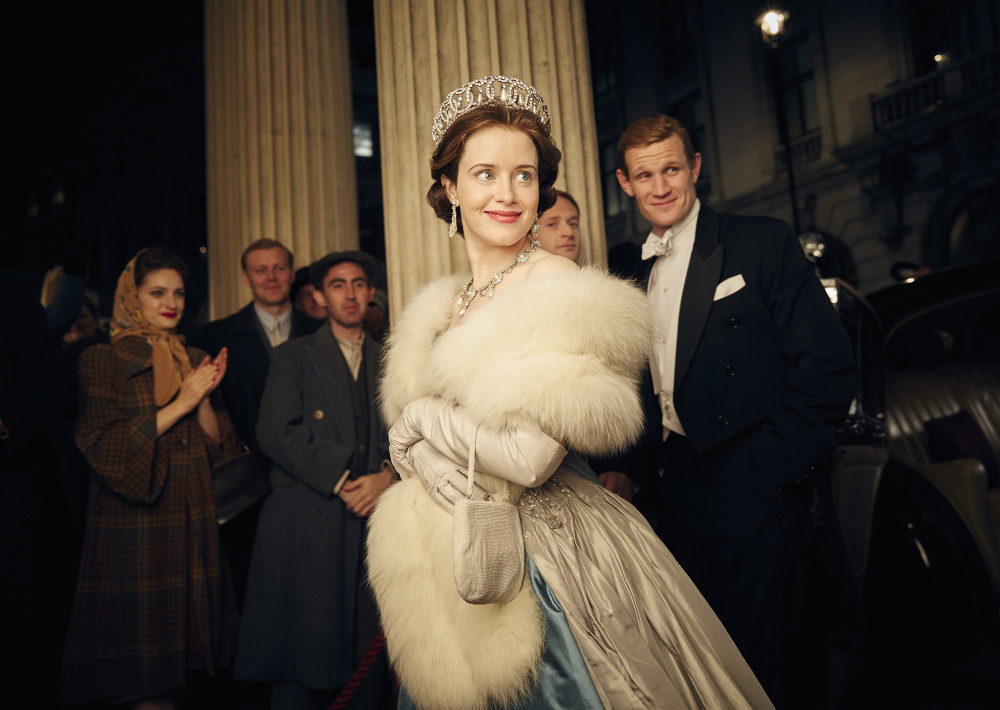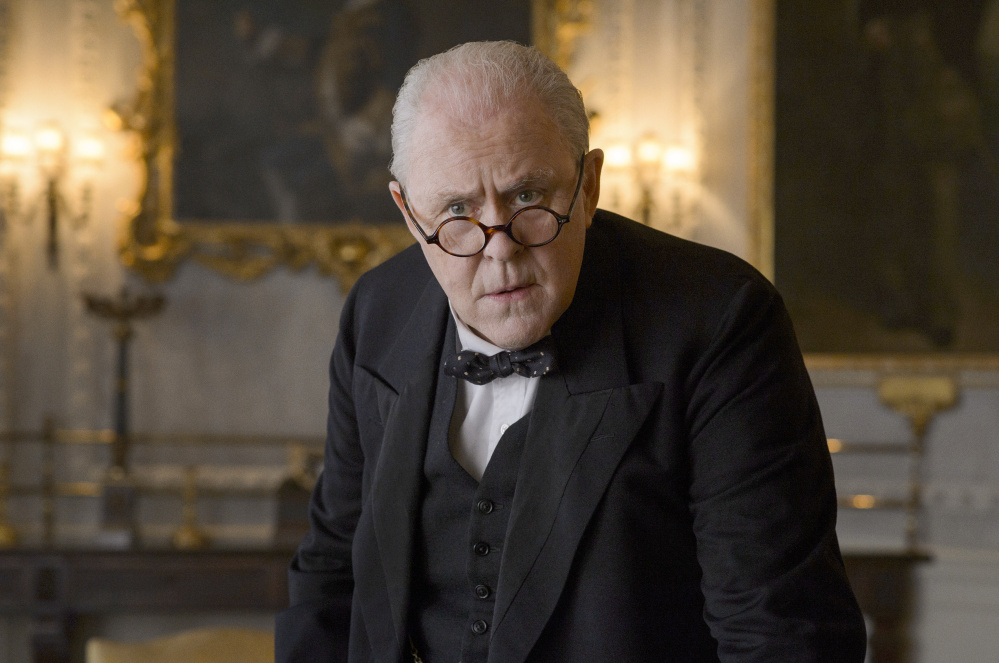Every crumb of Netflix’s Buckingham Palace drama “The Crown” is scrumptious, all 10 hours of it, but job No. 1 remains the hardest: How do you make two of this planet’s dullest people even halfway interesting?
That would be Queen Elizabeth II and her husband, Philip Mountbatten, and the answer, of course, is to make them young again and more beautiful and fascinating than they probably ever were – or still are – in real life.
“The Crown,” which began streaming in November, qualifies as the epic masterwork from creator/writer Peter Morgan, who has come at the modern Elizabethan era a couple of ways now, most notably with the 2006 film “The Queen,” an intimate rumination on the burdens of royalty in the scandal-driven infotainment era, when an aging Elizabeth (Helen Mirren, in an Oscar-winning performance) fought to comprehend the national grief and dismaying shift in protocol that followed the tragic 1997 death of her ex-daughter-in-law, Diana.
“The Queen” excelled by zeroing in on a one-week period, chronicling a crisis of public relations. “The Crown” is a deeper and more deliberately constructed saga, spanning eight years, starting with the 1947 wedding of Elizabeth (”Wolf Hall’s” Claire Foy) and Philip (”Doctor Who’s” Matt Smith) and working its way through the earliest years of her marathon reign. Even then – especially then – every action in Elizabeth’s life would be pre-considered through the optics of public perception, in a palace still roiled by the shocking abdication 11 years earlier of her uncle (Alex Jennings), known to the family as David and to the world, briefly, as King Edward VIII. She’s a girl who understood early on that her life would never be her own.
The essential theme, therefore, is always the same: “The Crown” invites sympathy about the burden of duty and the loss of self in service to country. From the amount of blood that Elizabeth’s father, King George VI (Jared Harris), keeps discreetly coughing into his handkerchiefs, it can only be a matter of time before the young bride ascends to the throne – and Morgan gets there in a matter of two episodes, which feels a little rushed.
NOT A LOVE STORY
The first episode is curiously stripped of character development, and the pace seems slightly off. Viewers never learn why Elizabeth loves Philip or why he loves her – or even how they met and decided to marry. There is whispered disapproval of the marriage from Elizabeth’s mother (Victoria Hamilton) and her grandmother (Eileen Atkins), but it’s up to you to Google around and figure out why from royal historians. Only after two episodes does it become clear that Morgan isn’t interested in making a love story.
Instead, it’s about a house full of people experiencing their own versions of identity crises: a queen terrified of seeming incompetent; a husband who feels publicly and personally emasculated. To that add a sister, Princess Margaret (Vanessa Kirby, going at it with true relish), whose casual take on celebrity is about 40 years ahead of her time, with instincts that are more Kardashian than Windsor. Finally there’s the biggest prima donna – the entitled, petulant, newly re-elected prime minister, Winston Churchill. John Lithgow plays the part with such a commanding presence that it becomes surprising and genuinely moving as the layers are peeled back and we see Churchill at his most vulnerable.
After the royal wedding, which is lovely to look at, we jump so far ahead that their first two children, Charles and Anne, are already ignored and seldom-seen toddlers. Not one episode – nor any significant scene – examines Elizabeth’s feelings about motherhood or the traveling that took her away from her children for weeks and months at a time. We learn more about her relationship to her champion horses and her companionable corgis. For all the beauty and grace that Foy brings to the part (a little too much of both), her performance and Morgan’s writing struggle most in moments meant to humanize the central character. Heavy lies “The Crown,” indeed.
And so the show’s sense of momentum relies mainly on tragically beautiful eye candy, high manners and lifestyle – the building blocks of televised Anglophilia. It’s so much to look at and consider, it often feels like Netflix has given us an extravagant and beautifully wrapped present. Morgan excels at mixing the historical record with sensitive imagination – he takes us inside the hushed elegance of Elizabeth and Philip’s world with such a careful instinct for realism and detail that makes it easy to believe that what we’re seeing is exactly how it happened.
But it’s not all luxurious fluff and nonsense – and anyone who tells you that “The Crown” is the new “Downton Abbey” has beans for brains. “The Crown” is far more thoughtful and serious than Julian Fellowes’s sudsy fixation with the incidental dramas between the upstairs and downstairs.
What viewers have here is the opportunity to watch 10 one-hour movies about Queen Elizabeth’s world. It’s one of the rare cases in which I’d recommend watching the series slowly, at a rate of one episode per week, if you can show that sort of discipline. Pieces of “The Crown” are more brilliant on their own than they are as a series, taken in as shorter, intently focused films like “The Queen” and another Morgan achievement, the play and film versions of “Frost/Nixon.”
There could, for example, be a stand-alone movie in the episode where Elizabeth discreetly employs a tutor (Alan Williams) to help fill in the gaps in her dreadfully narrow education. There could also be a terrific movie in the testy but meaningful exchanges between Churchill and painter Graham Sutherland (Stephen Dillane), who is hired to make a portrait of the prime minister at 80. (Churchill hated the painting, by many accounts a masterpiece. Lady Churchill, played by Harriet Walter, had it destroyed.)
And smack in the middle of the series, there’s a terrific mini-movie about Elizabeth’s official coronation, not up close and personal, but as seen from Paris, where a disinvited Uncle David, the Duke of Windsor, gathers friends and his wife, Wallis Simpson (Lia Williams), to watch the event on the newfangled telly. After flinging a few barbs at the young woman he nicknamed “Shirley Temple,” the duke finds himself deeply moved by the ceremony.
“Symbol upon symbol,” he says. “An unfathomable web of arcane mystery and liturgy, blurring so many lines no clergyman or historian or lawyer could ever untangle any of it.”
“It’s crazy,” one of his guests remarks.
“On the contrary, it’s perfectly sane,” the duke replies. “Who wants transparency when you can have magic? Who wants prose, when you can have poetry? Pull away the veil and what are you left with? An ordinary young woman of modest ability and little imagination. Wrap her up like this and anoint her with oil and hey, presto – what do you have? A goddess.”
Then and now, you also have captivating TV.
Send questions/comments to the editors.




Success. Please wait for the page to reload. If the page does not reload within 5 seconds, please refresh the page.
Enter your email and password to access comments.
Hi, to comment on stories you must . This profile is in addition to your subscription and website login.
Already have a commenting profile? .
Invalid username/password.
Please check your email to confirm and complete your registration.
Only subscribers are eligible to post comments. Please subscribe or login first for digital access. Here’s why.
Use the form below to reset your password. When you've submitted your account email, we will send an email with a reset code.